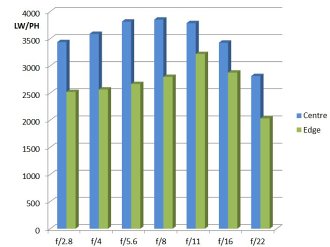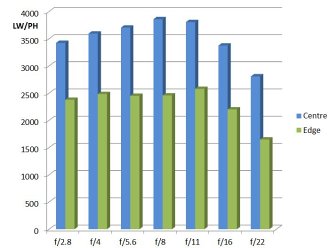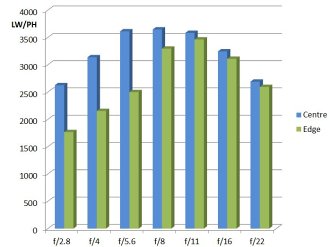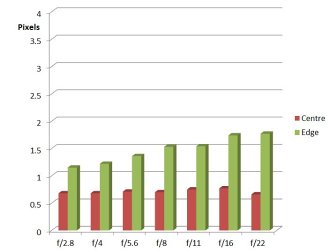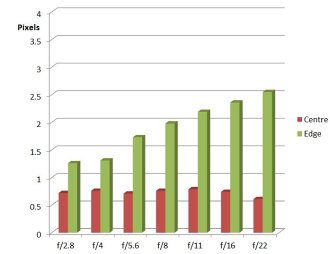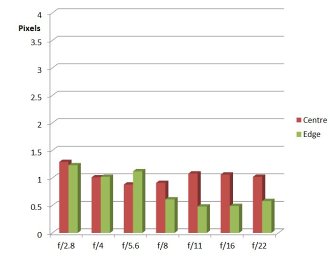Nikon AF-S NIKKOR 24-70mm f/2.8E ED VR Review
Nikon AF-S NIKKOR 24-70mm f/2.8E ED VR Performance
In terms of sharpness, the lens does indeed deliver across the range. At 24mm results are excellent from the start, peaking at f/8 and only really dropping significantly to very good levels at f/22. The edges do lag behind, but are already approaching very good levels wide open and peaking at around f/11. An overall very impressive performance.
35mm follows this with another impressive performance, excellent throughout and peaking at f/8. Sharpness does dip at f/22 but remains very good. The edges maintain a good to very good level of sharpness, except at f/16 and f/22 where performance falls off, reaching only fair levels at f/22. Nonetheless, still impressive, especially in the centre.
At 70mm sharpness is lower at f/2.8, but still very good. This becomes excellent by f/5.6, peaks at f/8 and maintains this level well at f/11. Again. f/22 sees a drop off in sharpness. The edges are fairly soft at f/2.8, although perhaps in portraiture this could even be an advantage. The sharpness gradually improves and reaches an excellent peak at f/11. There is the expected fall off at f/22, although even here the result is good.
How to read our charts
The blue column represents readings from the centre of the picture frame at the various apertures and the green is from the edges.The scale on the left side is an indication of actual image resolution as LW/PH. The taller the column, the better the lens performance. Simple.
For this review, the lens was tested on a Nikon D810 using Imatest.
CA (Chromatic Aberration) at 24mm is fairly well controlled at the centre, being well held to less than three quarters of a pixel. The edges are more obvious and there is some colour fringing in tree branches and similar subjects. At 35mm the central CA remains tightly controlled but the edges slip a little further. At 70mm the centre is almost as good and the edges actually come back under control to quite an extent. It can be dealt with in software.
How to read our charts
Chromatic aberration is the lens' inability to focus on the sensor or film all colours of visible light at the same point. Severe chromatic aberration gives a noticeable fringing or a halo effect around sharp edges within the picture. It can be cured in software.Apochromatic lenses have special lens elements (aspheric, extra-low dispersion etc) to minimize the problem, hence they usually cost more.
For this review, the lens was tested on a Nikon D810 using Imatest.
Looking at the results, the bokeh, that is, the rendering of the out of focus areas in an image, is very smooth and pleasant. This gives a very pleasing pictorial quality to images, making the lens ideal for a very wide variety of subject matter.
The VR system proves to be quite correct in its claim to give a 4 stop advantage when hand holding. At 70mm, shots at 1/5s are hopelessly blurred with VR switched off. With VR on, they are sharp and could in isolation be very acceptable. However, at 1/10s they become critically sharp and the difference can be seen. VR seems to work less well at higher shutter speeds, so for action shots it may not be needed and be better switched off. Likewise, on a tripod it may well be better to switch off. In any event VR will be no help with subject movement, but it is of immense value with most hand held shots.
Looking at the optical performance, distortion is quite evident. 24mm measures at -3.73% Barrel distortion. By 35mm this measures +0.68% pincushion and this increases at 70mm to +1.94% pincushion. This is pretty much in line with expectations for a zoom of this type and although the 24mm level is quite noticeable the telephoto end of the scale give fairly acceptable levels. This can of course be addressed in software.
Flare is probably the least satisfactory quality of the lens and results in quite a reduction in contrast and detail when shooting directly into the sun. In less extreme and more normal shots flare levels are manageable and at least do not result in excessive image artifacts. Nikon has overall done well with such a complex lens construction.
The overall optical performance is of a very high standard and should easily satisfy the most critical users.
Value For Money
The Nikon AF-S Nikkor 24-70mm f/2.8E ED VR Lens is currently priced at £1849, although this may well fall over time. The previous lens is the Nikkor 24-70mm f/2.8G AF-S ED at £1199, but personally I feel that the added VR and improved optical design could well be worth the difference.
Alternatives include the Tamron 24-70mm f/2.8 Di VC USD SP (£679) and the Sigma 24-70mm f/2.8 IF EX DG HSM (£549).
Looking further afield, for comparison, Canon users would perhaps be looking at the EF 24-70mm f/2.8 L II USM lens at £1400. This might indicate that the new Nikon will fall a bit in price yet, which would need to happen for it fall into line more with the others. It could still be worth its premium price.
For more options have a look at to Top 5 Best Nikon Lenses of 2015.
Add your message
Please login here or if you've not registered, you can register here. Registering is safe, quick and free.
photodo Stats
428 MTF tests
74 in-depth photodo reviews
100+ users join each day
Help the lens community by reviewing or rating a lens today via our lens search
Latest Lens Reviews
- Chinon 28mm f/2.8 Vintage Lens Review
- Canon EF 70-200mm f/4L IS II USM Lens Review
- Samyang AF 85mm f/1.4 EF Review
- Sigma 70mm f/2.8 DG Macro Art Review
- Samyang AF 24mm f/2.8 FE Review
- Meike 50mm f/1.7 Review
- Tamron 70-210mm f/4 Di VC USD Review
- Lensbaby Burnside 35mm f/2.8 Review
- Asahi Super Takumar 50mm f/1.4 Review
- Asahi Super-Multi-Coated Takumar 135mm f/3.5 Review
